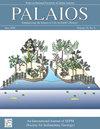AVIAN FORAGING ON AN INTERTIDAL MUDFLAT SUCCESSION IN THE EOCENE TANJUNG FORMATION, ASEM ASEM BASIN, SOUTH KALIMANTAN, INDONESIAN BORNEO
IF 1.5
4区 地球科学
Q2 GEOLOGY
引用次数: 0
Abstract
Moderately diverse trace fossil assemblages occur in the Eocene Tambak Member of the Tanjung Formation, in the Asem Asem Basin on the southern coast of South Kalimantan. These assemblages are fundamental for establishing depositional models and paleoecological reconstructions for southern Kalimantan during the Eocene and contribute substantially to the otherwise poorly documented fossil record of birds in Island Southeast Asia. Extensive forest cover has precluded previous ichnological analyses in the study area. The traces discussed herein were discovered in newly exposed outcrops in the basal part of the Wahana Baratama coal mine, on the Kalimantan coast of the Java Sea. The Tambak assemblage includes both vertebrate and invertebrate trace fossils. Invertebrate traces observed in this study include Arenicolites, Cylindrichnus, Diplocraterion, Palaeophycus, Planolites, Psilonichnus, Siphonichnus, Skolithos, Thalassinoides, Taenidium, and Trichichnus. Vertebrate-derived trace fossils include nine avian footprint ichnogenera (Aquatilavipes, Archaeornithipus, Ardeipeda, Aviadactyla, cf. Avipeda, cf. Fuscinapeda, cf. Ludicharadripodiscus, and two unnamed forms). A variety of shallow, circular to cylindrical pits and horizontal, singular to paired horizontal grooves preserved in concave epirelief are interpreted as avian feeding and foraging traces. These traces likely represent the activities of small to medium-sized shorebirds and waterbirds like those of living sandpipers, plovers, cranes, egrets, and herons. The pits and grooves are interpreted as foraging traces and occur interspersed with both avian trackways and invertebrate traces. The trace fossils occur preferentially in heterolithic successions with lenticular to flaser bedding, herringbone ripple stratification, and common reactivation surfaces, indicating that the study interval was deposited in a tidally influenced setting. Avian trackways, desiccation cracks, and common rooting indicate that the succession was prone to both subaqueous inundation and periodic subaerial exposure. We infer that the Tambak mixed vertebrate-invertebrate trace fossil association occurred on channel-margin intertidal flats in a tide-influenced estuarine setting. The occurrence of a moderately diverse avian footprint and foraging trace assemblage in the Tambak Member of the Tanjung Formation illustrates that shorebirds and waterbirds have been using wetlands in what is now Kalimantan for their food resources since at least the late Eocene.印度尼西亚波罗的海南加里曼丹阿森盆地始新世丹戎地层潮间带泥滩演替中的鸟类觅食活动
南加里曼丹南海岸阿瑟姆阿瑟姆盆地丹戎地层始新世丹巴克组(Tambak Member of the Tanjung Formation)中出现了中等多样性的痕量化石群。这些化石群对于建立始新世时期加里曼丹南部的沉积模型和古生态重建具有重要意义,同时也为东南亚岛屿鸟类化石记录的完善做出了巨大贡献。大面积的森林覆盖排除了以前在研究地区进行鸟类化石分析的可能性。本文讨论的踪迹是在爪哇海加里曼丹海岸瓦哈纳巴拉塔玛煤矿基底部分新暴露的露头中发现的。坦巴克化石群包括脊椎动物和无脊椎动物痕迹化石。本研究观察到的无脊椎动物痕迹化石包括 Arenicolites、Cylindrichnus、Diplocraterion、Palaeophycus、Planolites、Psilonichnus、Siphonichnus、Skolithos、Thalassinoides、Taenidium 和 Trichichnus。脊椎动物的痕迹化石包括九个鸟类足迹化石属(Aquatilavipes、Archaeornithipus、Ardeipeda、Aviadactyla、cf.Avipeda、cf.Fuscinapeda、cf.Ludicharadripodiscus 和两个未命名的种类)。保存在凹面外壁上的各种圆形到圆柱形浅坑和水平、单个到成对的水平凹槽被解释为鸟类觅食的痕迹。这些痕迹可能代表了中小型岸鸟和水鸟的活动,如活鹬类、鸻类、鹤类、白鹭和苍鹭。凹坑和凹槽被解释为觅食痕迹,与鸟类足迹和无脊椎动物足迹交错出现。痕量化石优先出现在具有透镜状至扇形层理、人字形波纹层理和常见再活化面的异石层中,这表明研究区间是在潮汐影响环境中沉积的。鸟类足迹、干燥裂缝和常见的根系表明,该演替既容易受到水下淹没,也容易受到周期性的海下曝露。我们推断,坦巴克混合脊椎动物-无脊椎动物痕量化石群发生在受潮汐影响的河口环境中的河道边缘潮间带滩涂上。丹戎地层丹巴克组中出现了中等多样性的鸟类足迹和觅食痕迹组合,说明至少从始新世晚期开始,海岸鸟类和水鸟就一直在利用现在加里曼丹的湿地作为食物资源。
本文章由计算机程序翻译,如有差异,请以英文原文为准。
求助全文
约1分钟内获得全文
求助全文
来源期刊

Palaios
地学-地质学
CiteScore
2.80
自引率
12.50%
发文量
40
审稿时长
6 months
期刊介绍:
PALAIOS is a monthly journal, founded in 1986, dedicated to emphasizing the impact of life on Earth''s history as recorded in the paleontological and sedimentological records. PALAIOS disseminates information to an international spectrum of geologists and biologists interested in a broad range of topics, including, but not limited to, biogeochemistry, ichnology, paleoclimatology, paleoecology, paleoceanography, sedimentology, stratigraphy, geomicrobiology, paleobiogeochemistry, and astrobiology.
PALAIOS publishes original papers that emphasize using paleontology to answer important geological and biological questions that further our understanding of Earth history. Accordingly, manuscripts whose subject matter and conclusions have broader geologic implications are much more likely to be selected for publication. Given that the purpose of PALAIOS is to generate enthusiasm for paleontology among a broad spectrum of readers, the editors request the following: titles that generate immediate interest; abstracts that emphasize important conclusions; illustrations of professional caliber used in place of words; and lively, yet scholarly, text.
 求助内容:
求助内容: 应助结果提醒方式:
应助结果提醒方式:


